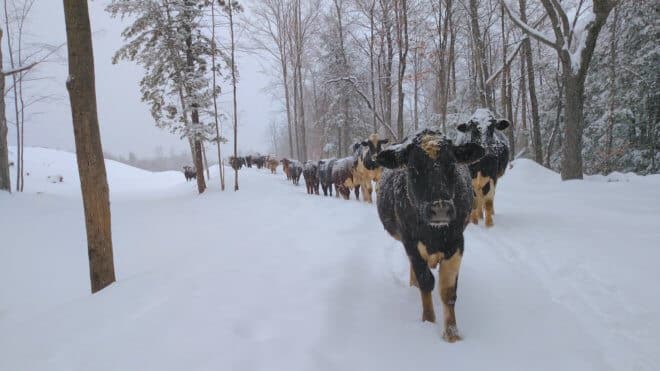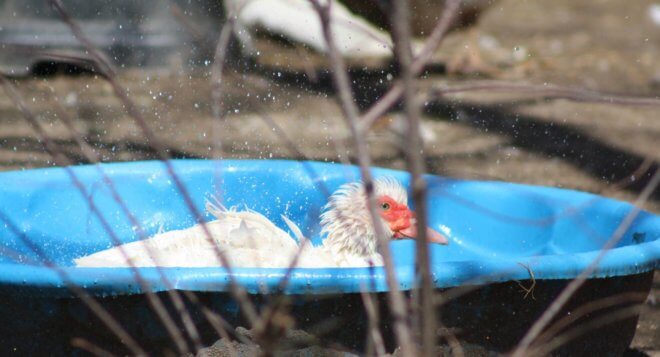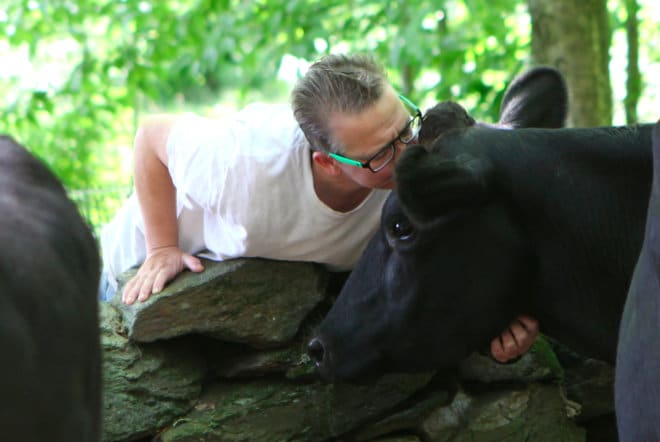Dr. Bronner’s “All-One Activist” series profiles influential activists who are advancing the core causes that Dr. Bronner’s supports through its philanthropy and advocacy work, including: animal advocacy, regenerative organic agriculture, drug policy reform, and community work. Featured photo courtesy of VINE Sanctuary.
Dr. Bronner’s has been supporting VINE Sanctuary for more than five years by providing resources to increase wages for sanctuary employees, and supporting their education and advocacy programs. The goal is to undermine the social and structural causes of animal exploitation, and promote a plant-based agricultural economy.
Co-founders pattrice and Miriam Jones founded the Eastern Shore Chicken Sanctuary in Maryland in 2000, before moving to Vermont in 2009 and launching VINE Sanctuary—which had more land and allowed them to rescue cows exploited by the dairy industry.
We’re incredibly proud to support the important work the VINE Sanctuary does to advocate for exploited animals, and challenge unethical systems that impact all animals, including humans. It was an honor to talk with VINE co-founder pattrice jones and learn more about life at the sanctuary. We’re publishing this on World Vegan Day, which also happens to be pattrice’s birthday. Happy Birthday, pattrice!
How did you first become aware of issues around animal exploitation and decide you wanted to do something about it?
One day, when I was maybe seven to nine years old, one of the other kids on my block in Baltimore city shouted at all of the other children to “get off our property!” This was a block of small brick row houses, each of which had a small grass plot. Later that day, I stood with one foot on the public sidewalk and one foot on our own grass plot, shifting my weight back and forth while saying “our property, not our property, our property, not our property,” trying to figure it out. I knew that my grandparents must have bought the house from somebody who bought it from somebody who bought it from somebody else…but how did the land become “property”? I imagined a Pilgrim (wearing one of those distinctive hats) clearing a plot in the forest, building a stone wall around it, and then using his musket to threaten any Native American who came near.
I looked up at the maple tree, whose helicopter seeds I loved playing with each year, and it seemed nonsensical to me that walls or guns could turn a tree that grew on its own into property. Then I imagined squirrels playing in fallen leaves and wondered if that imaginary Pilgrim could claim that he owned them too, just because he had built a wall and had a gun. That felt so unfair! Of course, it would be many years before I would translate that feeling of wrongness into a critique of colonialism and property, but I’ll never forget how outraged I felt upon first seeing the violence built into my own habitat.
I quit eating meat as a teen in the mid-1970s, the same year that I attended my first gay rights rally, but it would be many years before I would come to understand how deeply those two choices were linked. In both cases, I now see, I was seizing my own heart’s desire despite what the dominant culture told me I should want.

Before I came to understand that, I thought about my vegetarianism as a personal choice that had nothing to do with my work as a social justice activist. As an AIDS activist, a tenant organizer, and an anti-racist educator, I insisted that everybody see how the various ways that people hurt each other are connected, but I didn’t include animals in my analysis. It was only when my dissertation research into the history of racism led me back to the historical links between pastoralism and patriarchy—back in the days when both daughters and dairy cows were the property of husbands—that I begin to see the foundational role of speciesism in social injustice.
At the same time, Miriam and I were learning about modern-day abuses of animals, such as vivisection and factory farming. Shortly after unknowingly moving to the part of the country where factory farming of chickens was invented and perfected, we found an escapee from a nearby factory farm in a ditch by the side of the road. This coming January will be the 20th anniversary of that accidental origin of VINE Sanctuary.
Walk us through a day at VINE Sanctuary—how many animals do you currently care for, and what kind of programs are you working on?
Our community includes more than 600 nonhuman sanctuary residents, including chickens, cows, ducks, goats, geese, sheep, turkeys, alpacas, emus, pigeons, and one exceptional pig. They include survivors of every kind of animal agriculture—both large- and small-scale dairying, “meat” production, and egg production—as well as other abuses, such as petting zoos and cockfighting. Some were rescued by authorities, due to extreme cruelty or neglect. Some were surrendered by people no longer able to feed or care for them, while others liberated themselves by escaping.
Rain or shine, blizzard or heatwave, our workday starts at sunrise. If you were here at that time, you’d know why we never let people get away with referring to animals as “voiceless.” Except in the worst of weather, chickens and other birds want to be OUTSIDE as soon as it’s fully light, and say so loudly. We have open-plan barns, so the cows and other mammals can come and go as they please at night (cows like to sleep out under the trees unless it’s raining or snowing). But they too will become very vocal if breakfast is delayed for any reason.
We occupy two adjoining properties stretched over more than 100 hilly acres (half of which we maintain as wildlife reserve). In “the valley,” there’s one house, plus several coops and aviaries. “Up the hill” is another house, a big barn with several coops attached, and a few more free-standing coops. Beyond that is “the back pasture” with another barn surrounded by several forested acres. We need at least two people for opening chores, which include opening all the coops, filling all the feed bowls and water troughs, making sure that those on special diets get their breakfasts, and distributing meds to anyone who needs them. Next comes putting out hay—a job for the big tractor—and starting the long slog of cleaning two big barns, nine coops, three aviaries, and two infirmaries. Throughout the day, waters must be refreshed regularly. And then there are all of the weekly, semi-weekly, monthly, and seasonal chores that have to be squeezed in as possible, depending on the demands of any given day.

The outdoor day ends at sunset, when meds and special diets are again distributed before the birds go back into the coops. But that’s just animal care! We also organize or participate in about 60 events each year, ranging from local workshops on veganic gardening to international conferences on topics such as decolonial approaches to animal advocacy.
Locally, we run a humane education program for children and also maintain a Free Seed Library at the local public library. Within Vermont, we coordinate a coalition effort promoting plant-based alternatives to dairying. Nationally, we speak to campus and community groups on topics such as the links between ableism and speciesism, “eco-logical” activism, and queering animal liberation.
As an acronym, VINE stands for “Veganism is the Next Evolution.” What does this evolution mean to you?
By “Veganism Is the Next Evolution,” we mean that going vegan is a necessary next step in the movements for social and environmental justice. But VINE also stands for “Veganism Is Not Enough.” By that, we mean that veganism is only a baseline, a necessary but not sufficient way of minimizing the suffering and environmental despoliation for which you are personally responsible, while also actively working for structural change in some way. You can be a vegan prison abolitionist, a vegan disability rights activist, a vegan animal liberation activist, or all of the above and more. When it comes to climate change, again: veganism is necessary, as long as you have sufficient income and access to food, but we all need to do more—including working to make sure everybody who wants to be vegan can do so, which means supporting a higher minimum wage as well as access to fresh produce and bulk pulses and grains in every community.
Can you tell us a bit about your work around the concept of “queering animal liberation”?
As an LGBTQ-led animal sanctuary, we have taken the lead in uncovering the linkages between speciesism and homophobia & transphobia and building bridges between the animal and LGBTQ+ liberation movements. Since 2002, we have led workshops and discussions at which LGBTQ+ activists explore topics such as the role that toxic masculinity plays in both animal exploitation and homo/transphobic hate crimes. It’s not by accident that boys and men who shun hunting or go vegan often are called homophobic names, regardless of their actual sexual orientations. Since recent research has shown that men who endorse traditional notions of masculinity are less likely to engage in environmentally sustainable behavior, like using reusable grocery bags, this is a problem for everybody.
The VINE Sanctuary operates in dairy country. How has the local community reacted to your work rescuing abused dairy cows?
Most people consider kindness to animals to be a virtue. Most people hope that, when animals are seized by authorities due to extreme cruelty or surrendered by people who can no longer care for them due to poverty or disability, there will be somewhere safe for them to go. And so, whether or not they agree with us about veganism or the dairy industry, most people in our local community seem to be glad that the sanctuary is here. I’m sure that our local projects, such as the seed library and our children’s programs, contribute to that gladness.

We consider ourselves part of our local community, and we feel a responsibility to contribute to its vitality. We’re located in the rural surrounds of a small town struggling with poverty, opiate addiction, and population decline. We’ve got boarded-up buildings on main street and a hospital in perpetual bankruptcy. We do our part by bringing in grants and donations from elsewhere and spending that money locally. We work with other local nonprofits to create opportunities for young people, people with disabilities, and survivors of violence to come to the sanctuary to experience the solace and purpose that can come from volunteering to help animals.
We also organize events in town, such as workshops on gardening or vegan potlucks where anyone can come to eat, whether or not they bring a dish to share. I know that a lot of people feel confusion and despair right now about the things that are happening nationally and globally. One remedy for that despair also happens to be a necessary component of solving those national and global problems, and that is involving yourself in local efforts to transform our communities from the ground up.
What is the most effective way you have found to approach people about the interconnections between animal liberation and so many other forms of injustice we see in society?
There’s no one-size-fits-all best approach, but I do find it useful to help people see the ways that speciesism contributes to the problems they are trying to solve and to do this as a person who also sincerely hopes to solve those problems. I also find it useful to help people remember their own desires and values, and to see that bringing themselves into better relationship with animals will lead to greater congruence within themselves. I don’t shy away from speaking hard truths, but I tend to use a low-key matter-of-fact tone, trusting that people will wrestle with what I’ve said over time in the privacy of their own consciences rather than trying to provoke a heated debate in which people might begin to feel defensive and thus become less likely to really hear what I’m saying.
I imagine that caring for other animals is hard work and extremely rewarding. How do they inspire you?
The most important of the many things I have learned from nonhuman animals is to “make the path by walking” rather than waiting until you feel inspired before acting. I do feel inspired, though, every time I see a formerly abused animal extend welcome and care to another animal. If a young chicken who knew nothing but suffering at a factory farm can turn around and try to help a more recently rescued bird, or a cow who was locked up alone in a shed for years can find the empathy to adopt a frightened lamb—and these things happen all the time at the sanctuary—then surely I can summon up more grace and generosity from my position of comparative privilege.

How does Dr. Bronner’s support your work on the ground at VINE Sanctuary?
Dr. Bronner’s support allowed us to raise the starting wage for our hard-working animal care team, which has improved their wellbeing, as well as the wellbeing of our local community. When the local public library said that they would love to host a seed library but had no funds for such a project, Dr. Bronner’s support allowed us to jump in and cover all of the costs of what is now a fixture in our community.
In terms of animal advocacy, Dr. Bronner’s support has helped us to begin to make headway on a question ignored by many vegan organizations: How, exactly, will rural regions that are currently dependent on animal agriculture transform themselves into vibrant plant-based agricultural economies? We’re in a perfect position to help the small state of Vermont—in which the declining dairy industry currently plays an outsized economic role—demonstrate that this is possible and can help, rather than hurt, rural economies and ecologies.
What’s your favorite Dr. Bronner’s product and scent?
I love peppermint soap in the summer, rose in the heart of winter, and eucalyptus when I’m feeling under the weather. Hands down, my favorite product is the liquid soap, which I use for everything:showering, laundry, housecleaning, and whatever else needs washing. The sanctuary uses it too, and we REALLY appreciate the gallons of soap the Dr. Bronner’s has donated over the years.